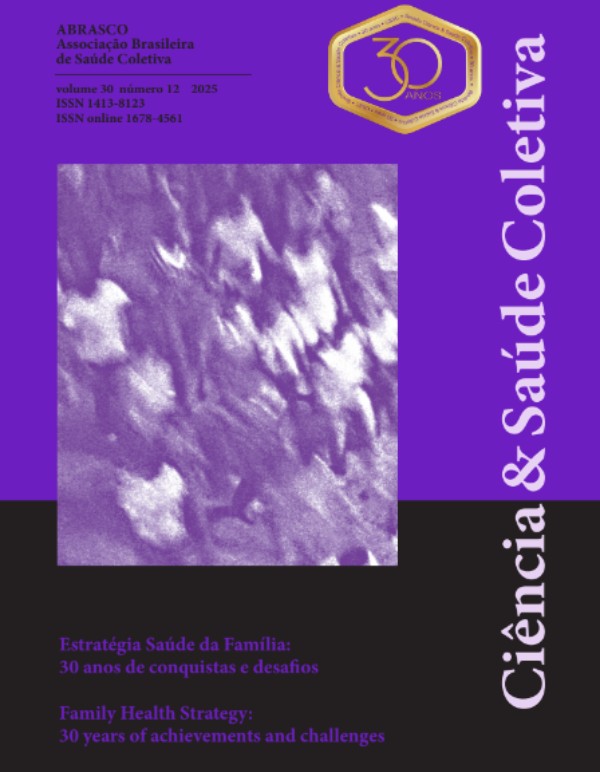0341/2024 - Prevalence of chronic diseases and factors associated with multimorbidity in the Brazilian Amazon: a cross-sectional population-based study, 2019
Prevalência de doenças crônicas e fatores associados à multimorbidade na Amazônia brasileira: estudo transversal de base populacional, 2019
Autor:
• Gustavo Magno Baldin Tiguman - Tiguman, G.M.B - <gustavo.tiguman@gmail.com>ORCID: https://orcid.org/0000-0001-9518-7194
Coautor(es):
• Marcus Tolentino Silva - Silva, M.T - <marcusts@gmail.com>ORCID: https://orcid.org/0000-0002-7186-9075
• Bruno Pereira Nunes - Nunes, B.P - <nunesbp@gmail.com>
ORCID: https://orcid.org/0000-0002-4496-4122
• Taís Freire Galvão - Galvão, T.F - <taisgalvao@gmail.com>
ORCID: https://orcid.org/0000-0003-2072-4834
Resumo:
BACKGROUND: This study aimed to assess the prevalence of multimorbidity and associatedfactors in Manaus, Brazil.
METHODS: Cross-sectional population-based study with individuals from Manaus selected via
probabilistic sampling in 2019. Multimorbidity was defined as ?2 self-reported chronic diseases.
Multimorbidity treatment included multimorbidity participants who received treatment for all
conditions. Limitations in daily activities were assessed via a 5-point Likert scale. Poisson
regression was used to calculate the prevalence ratios (PR) of multimorbidity with 95%
confidence intervals (95%CI).
RESULTS: Out of 2,321 participants, 30.6% (95%CI 28.7-32.4%) had multimorbidity (mean:
2.99±1.27 diseases), of whom 28.8% (95%CI 25.3-32.0%) were treated for all diseases. Back
pain, hypertension, and high cholesterol were the most prevalent conditions, while mental
illnesses, other less common conditions, and renal disease had the most severe limitations on
daily activities. Multimorbidity was higher in women (PR=1.46; 95%CI 1.28-1.66), older people
(p<0.001), and retired individuals (PR=1.41; 95%CI 1.13-1.75).
CONCLUSIONS: Nearly 30% of the population of Manaus has multimorbidity, which is
affected by socioeconomic factors; of those, approximately one-quarter receive multimorbidity
treatment.
Palavras-chave:
Multimorbidity; Chronic diseases; Cross-sectional studies; Mass screening; BrazilAbstract:
INTRODUÇÃO: Este estudo objetivou avaliar a prevalência de multimorbidade e fatoresassociados em Manaus, Brasil.
MÉTODOS: Estudo transversal de base populacional com indivíduos de Manaus selecionados
por amostragem probabilística em 2019. Multimorbidade foi definida como ≥2 doenças crônicas.
Tratamento de multimorbidade incluiu participantes com multimorbidade que receberam
tratamento para todas as condições. Limitações nas atividades diárias foram avaliadas por escala
Likert. Razões de prevalência (RP) de multimorbidade foram calculadas por regressão de
Poisson com intervalos de confiança de 95%.
RESULTADOS: Dos 2.321 participantes, 30,6% (IC95% 28,7-32,4%) tinham multimorbidade
(média: 2,99±1,27 doenças), dos quais 28,8% (IC95% 25,3-32,0%) foram tratados para todas as
doenças. Dor nas costas, hipertensão e colesterol alto foram as condições mais prevalentes.
Doenças mentais, outras condições menos comuns e doenças renais resultaram em limitações
mais graves. Multimorbidade foi maior em mulheres (RP=1,46; IC95% 1,28-1,66), idosos
(p<0,001) e aposentados (RP=1,41; IC95% 1,13-1,75).
CONCLUSÕES: Cerca de 30% da população de Manaus apresenta multimorbidade, sendo
afetada por fatores socioeconômicos; destes, aproximadamente um quarto recebe tratamento para
multimorbidade.













